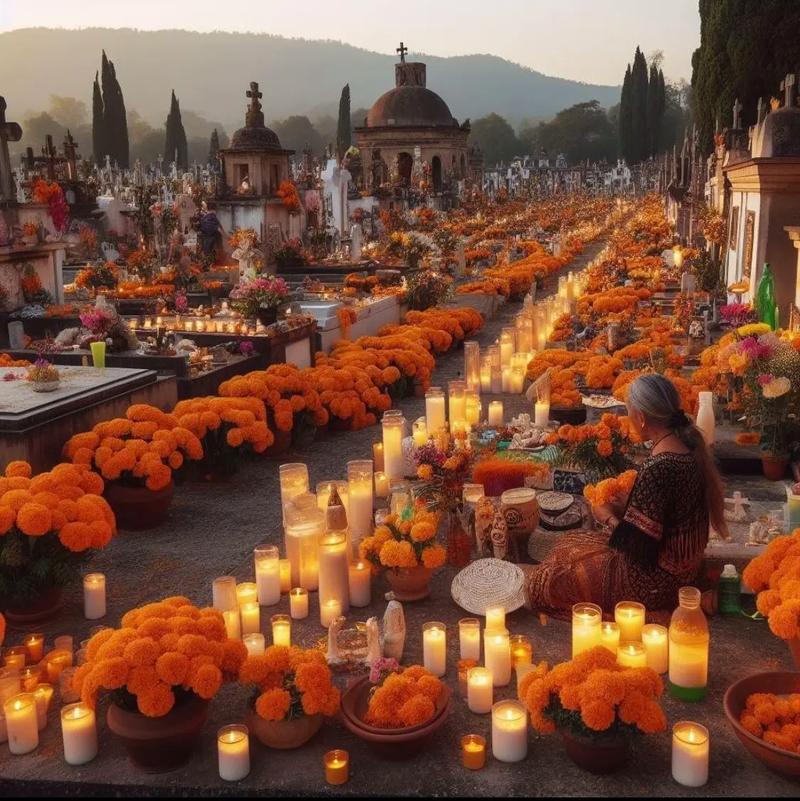Tone/Mood Associated with El D铆a de los Muertos
El D铆a de los Muertos, also known as the Day of the Dead, is a vibrant and deeply rooted tradition celebrated in Mexico and among Mexican communities worldwide. This holiday, which takes place on November 1st and 2nd, honors the memory of deceased loved ones with a blend of reverence, humor, and celebration. The mood associated with El D铆a de los Muertos is one of profound respect, joy, and a sense of continuity between life and death.
Colorful Celebrations and Decorations
One of the most striking aspects of El D铆a de los Muertos is the use of vibrant colors. The holiday is characterized by a palette of bright reds, oranges, yellows, and greens, which are believed to attract the spirits of the deceased. These colors are prominently featured in the decorations, including marigold flowers, sugar skulls, and papel picado (paper cutouts).

Marigolds, or cempas煤chil, are particularly significant as they are thought to guide the spirits back to the mortal world. The flowers are placed on altars, known as ofrendas, which are meticulously decorated with photographs of the deceased, candles, and offerings such as food, drinks, and incense.
Ofrendas: Altars of Remembrance
Ofrendas are the centerpiece of El D铆a de los Muertos celebrations. Each altar is unique and reflects the life and personality of the person being honored. The following table provides a breakdown of common elements found on an ofrenda:
| Element | Description |
|---|---|
| Photographs | Images of the deceased are displayed to welcome their spirits. |
| Candles | Red candles symbolize the blood of the dead and guide spirits back to the living. |
| Marigolds | These flowers are believed to attract the spirits and guide them back to the living world. |
| Food and Drink | Favorite dishes and beverages of the deceased are offered to nourish their spirits. |
| Incense | Smudging with incense is believed to purify the air and invite the spirits to join the celebration. |
| Sugar Skulls | Skulls made from sugar are a playful representation of death and are placed on the altar. |
Music, Dance, and Performance
Music and dance are integral to the celebration of El D铆a de los Muertos. Traditional Mexican music, such as mariachi and brass bands, fills the streets, while dancers perform traditional dances like the danza de la calavera (skull dance). These activities are meant to honor the deceased and invite their spirits to join the festivities.
La Catrina and La Calavera Catrina
La Catrina, a skeleton woman dressed in elegant, high-fashion attire, is a symbol of the elite class during the Porfiriato era in Mexico. She represents the blending of death and life, and her image is often seen during El D铆a de los Muertos celebrations. La Calavera Catrina, a skeleton version of La Catrina, is another popular symbol that embodies the playful and humorous side of the holiday.

El D铆a de los Muertos in the United States
El D铆a de los Muertos has gained popularity in the United States, particularly in areas with a significant Mexican population. The holiday is celebrated in various ways, from community events to school projects. In some cases, the celebration has been adapted to include elements from other cultures, creating a unique blend of traditions.
Conclusion
El D铆a de los Muertos is a holiday that encapsulates the rich cultural heritage of Mexico and its people. The mood associated with this celebration is one of profound respect for the deceased, mixed with joy and humor. Through vibrant decorations, ofrendas, music, and dance, El D铆a de los Muertos honors the lives of those who have passed while celebrating the enduring bond between the living and the dead.




